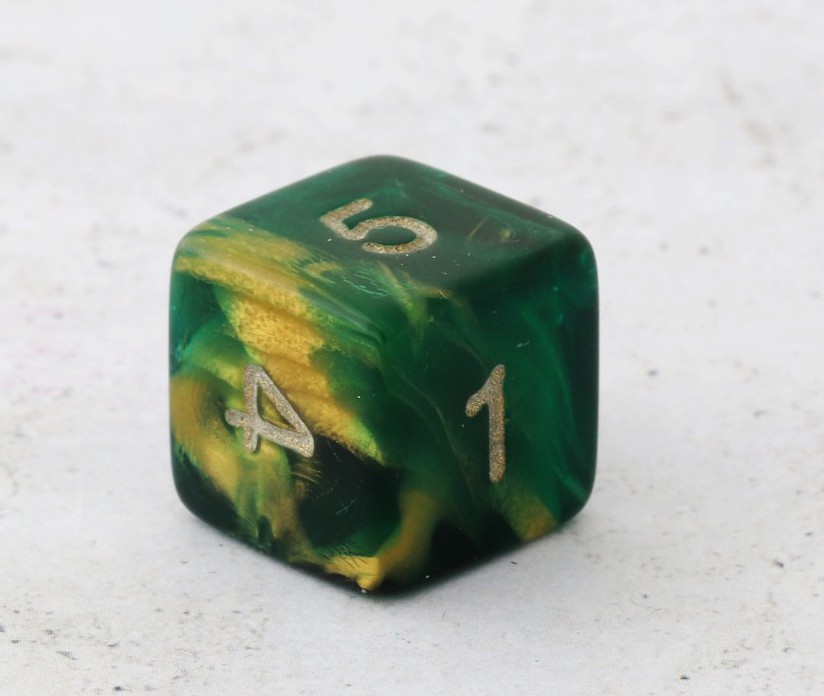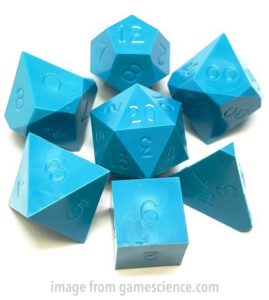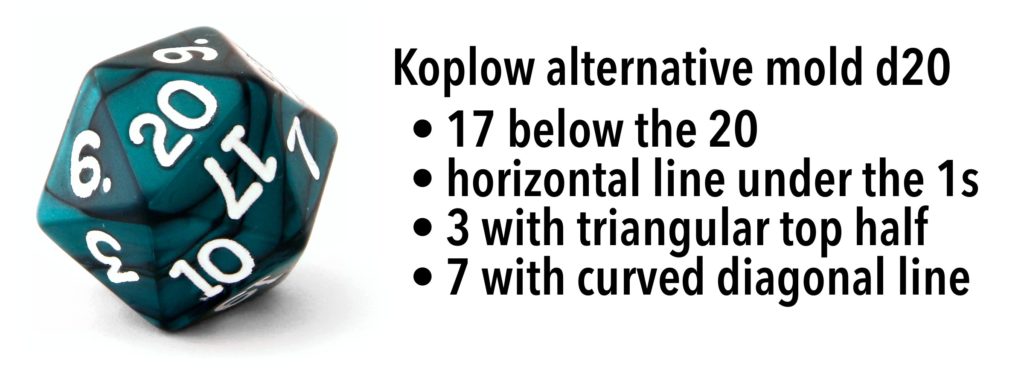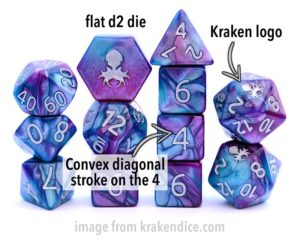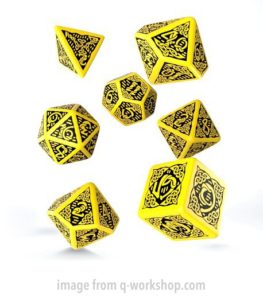“Does anybody know what these dice are?”
This question is asked a lot all across the dice groups, and it’s a blessing that we have many members in the community who have a vast knowledge of the different dice makers and manufacturers, and how you can tell them apart. However, it doesn’t require that you actually own or even know all the dice ever made to be able to come to a conclusion what “these dice” are.
This guide is aimed at showing and explaining some basic differences to help you make conclusions about the manufacturer from the way your dice in question look. It is not all-encompassing and isn’t featuring all available brands or all their mould variations.
It will focus on round-edged plastic dice, as there is not quite the same abundance of manufacturers out there for metal, wooden, gemstone or dice made from other materials as for acrylic or plastic dice. I will also not include handmade or mass-produced sharp-edged dice.
There are three basic indicators you can use to identify dice:
- The mould, which influences
- Size
- Font
- Shape
- The colour/colour combination
- Colour/colour combination of the die material
- Colour/colour combination of the die and the ink
- The feel and weight
I’ll start with the moulds on page 1 and will cover colours, ink and materials on page 2.
Mould Characteristics
Perhaps the most important piece to narrow down which manufacturer the dice are made by, is the mould. There are many differences in moulds, and it would go beyond the scope of this blog entry to explain all the existing moulds and their variances. Let’s try to get you started on a few basics that may be useful in determining what manufacturer we’re looking at.
As a disclaimer, I would like to add that this list isn’t exhaustive and doesn’t cover all the intricacies of mould variances per manufacturer. Some of these rules cannot be applied across the board for all lines of the below mentioned manufacturers.
Chessex
The modern Chessex lines (i.e. those made from approximately the late 1990s onwards) use the same mould and font, which is exclusive to Chessex and can relatively easily be identified. The typical telltale signs that you’re dealing with Chessex are an underlined 6 and/or 9, a 7 with a hook on the horizontal line, an upstroke on the 1, and a running track shaped 0 (straight lines linking the top and bottom arcs). The percentile dice are aligned perpendicular with the die’s equator. The numbers on the d4 are always top-read. The d20 has an 8 below the 20.
There are some older Chessex lines that use other moulds, for instance the Chessex Rainbow line (that was made by Dice & Games with their D&G moulds), or the Marbleized, Sparkle and Glo-Dice lines that use a mould from a no longer existing factory in Taiwan. Koplow and The Armory also sold dice made with that same mould and design made by the same Taiwanese factory, which makes it hard, or sometimes even impossible, to tell them apart.
The modern Chessex mould:

The modern Chessex acrylic dice are made at the German acylic factory, the opaque and Speckled dice are made the Danish urea factory. The Danish dice use the same font as the modern Chessex acrylic dice. There are older versions of Chessex Speckled and opaque dice that used an older mould, which is most recognisable by the d12 (smaller font) and the d20 (dots behind the 6 and 9 rather than underlined).
You may come across statements that talk about mould differences even between the newer Chessex mould acrylic dice, which stems from the fact that Chessex has severeal (at least three) physical acrylic moulds they use more or less in parallel which are all very slightly different. These differences are fairly minute (slightly longer or shorter curve on the 2, slightly more or less pronounced upstroke on the 1, etc.) and not many collectors know these well enough to even tell them apart in the first place.
Dice & Games
Dice & Games (D&G) is a factory that used to operate out of the UK, although the UK factory closed down a number of years ago and production has been moved to Bulgaria. D&G sold dice to several different brands, Crystal Caste is one of the brands who sold a lot of dice that use D&G moulds, although they also have some older lines that were made in Germany and use the old German mould.
One dice collector in particular with a keen eye has labeled these three different physical mould types Clarity, Standard and Nu. I don’t know enough about them to describe the exact characteristics, and these mould types are of little consequence since Chessex has all three still in use and the moulds don’t necessarily say anything about the age of the dice except that certtain dice made with the two newer moulds can’t be older than the date the moulds were made.
You can tell D&G moulds by the fact that the 6 and/or 9 has a dot behind the number, the 7 is not hooked, the 1 usually doesn’t have an upstroke (there are exceptions to this rule), the 0 is more rounded, and the 3 often has a triangular top half rather than rounded. The percentile dice have smaller numbers and are aligned in parallel with the die’s equator. The numbers on the d4 are always bottom-read.
Most D&G d20 moulds have either an 8 below the 20, or a 14. D&G dice also tend to be somewhat smaller compared to Chessex or newer dice out of China such as HD or Udixi. It is said that the d20 mould with the 14 below the 20 is older than then one with the 8. There are certain D&G sets that have a slighly different d6 with a font different than what is pictured below. This d6 uses a font that is more reminisent of the Arial/Helvetica font, has slightly larger numbers and an upstroke on the 1.
Example of one of the more common D&G moulds:

Please note that some D&G d20s have an 8 below the 20.
The Old German Mould
Some older dice use a mould that is often labeled as the old German mould since it is used solely by the German acrylic factory and mostly seen in dice that are now out of print, such as certain Chessex dice from before the 2000s or out of print Crystal Caste or King Cards dice.
Early sets in this mould were sold with an off-colour second d10 rather than a d%, the d% for some of the sets was only produced at a later time. Some sets in the old German mould never had d%s made (e.g. Crystal Caste Satin Honey or Satin Yellow).
This mould is characterized by the following:
- Open 4 on all dice, 3 has as rounded top half, running track shaped 0 except on d10
- d4 is bottom-read with no upstroke on the 1
- d6 has no upstroke on the 1 and no dot or underline for the 6
- d8 has a hooked 7 and either has an underlined 6, a mirrored 3 and no upstroke on the 1, or has a dot next to the 6, a regular 3 and an upstroke on the 1
- d10: underlined 6 and 9, hooked 7
- d%: similar to modern mould Chessex d% but no upstroke on the 1 and no hook on the 7, number alignment perpendicular to the die equator
- d12: hooked 7, no upstroke on the 1
- d20: similar to modern mould Chessex but slightly larger and different number layout, e.g. the 12 above the 20 (Chessex has an 8 below the 20), hooked 7, upstroke on the 1
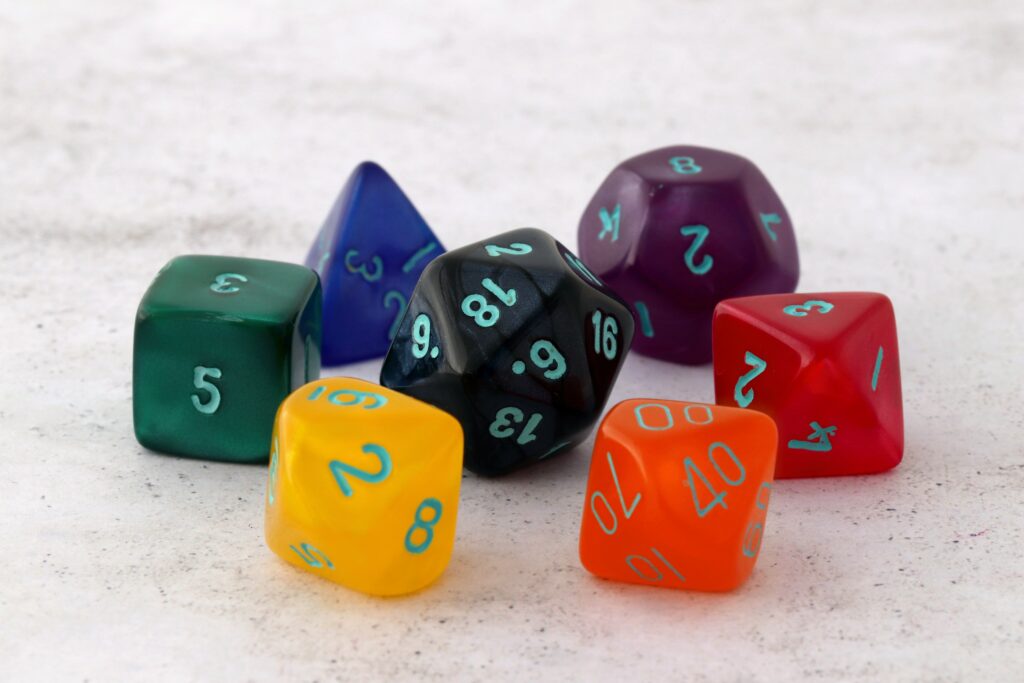
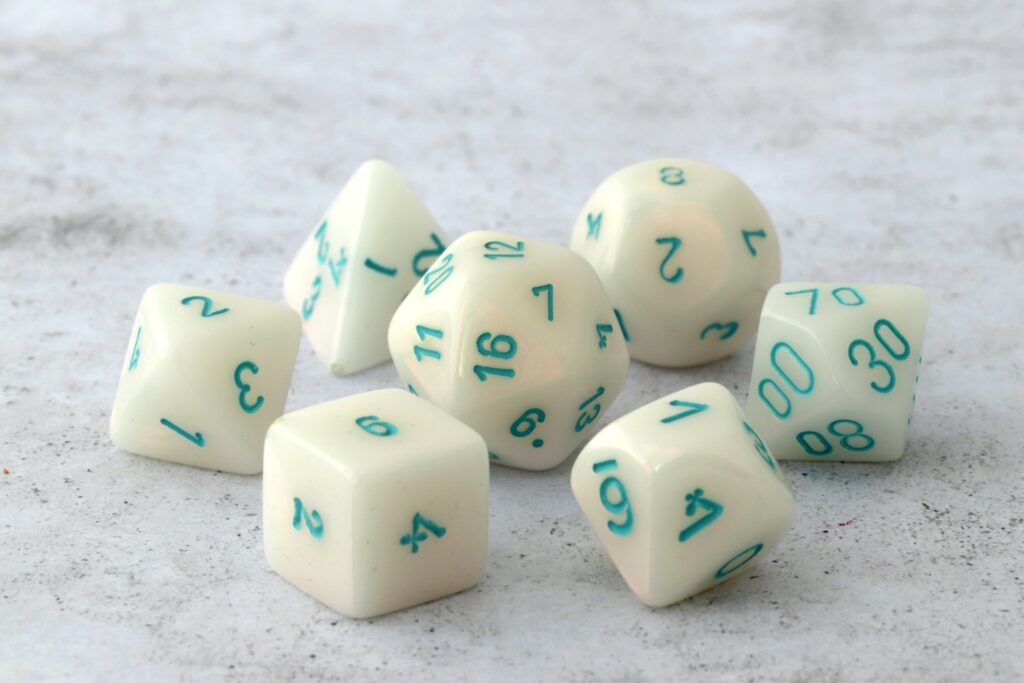
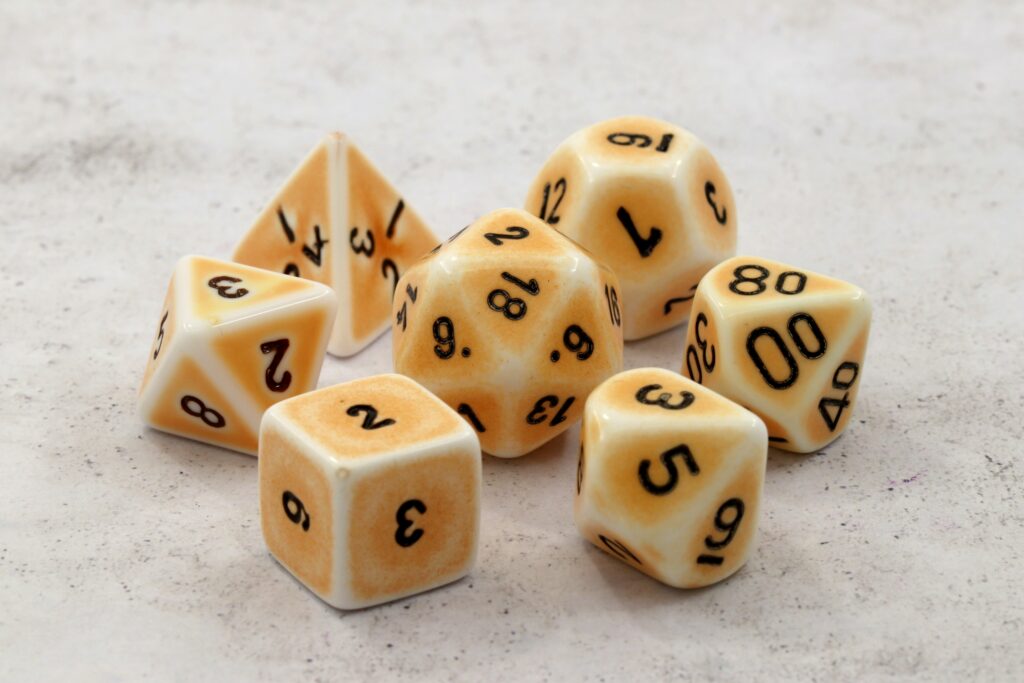
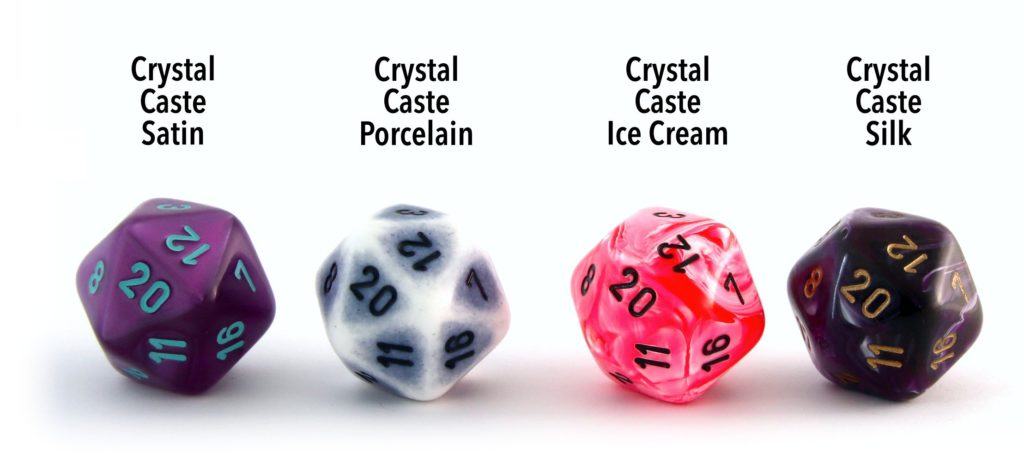
The Taiwan Mould
Some of the older acrylic dice from the early to mid 1990s were produced in Taiwan by a factory that doesn’t appear to be in the dice production picture anymore these days. Several different brands sourced the same dice from this factory, most prominently Chessex, Koplow and The Armory.
The Taiwan factory had one mould they worked with predominantly, this mould was used for dice designs we know as opaque, unicolour translucent, Marbleized, Glo, Neon or Sparkle/Glitter. This mould also went through a few iterations for some of the dice shapes. I’m not wholly familiar with all the details, but I know that the d6, d8 and d10 exists with minor variations in font.
Early sets in this mould were sold either as 6-die sets without a percentile die or with an off-colour second d10 rather than a d%. The d% for some of the sets was only produced at a later time, although certain sets in the Taiwan mould never had d%s made.
The Taiwan mould is characterized by the following:
- No hooks on the 7, inconsistent 3s among the different dice
- d4 is bottom-read with an upstroke on the 1, the 3 has a triangular top half
- d6 has an upstroke on the 1, a rounded top half 3 and an underlined 6
(there are two iterations of the d6 mould, one has slightly smaller numbers) - d8 has an underlined 6 and an upstroke on the 1, the 3 has a rounded top half
(there are two iterations of the d8 mould, one has more narrow numbers and one has wider, more round-bodied numbers) - d10: underlined 6 and 9, the 3 has a rounded top half, die shape is a bit more elongated compared to other d10s
(there are two iterations of the d10 mould, one has more narrow numbers with a running track shaped 0 and one has wider, more round-bodied numbers) - d%: no upstroke on the 1, the 3 has a triangular top half, number alignment parallel to the die equator, die is smaller than the d10
- d12: slight upstroke on the 1, horizontal bar at the bottom of the 1, the 3 has a triangular top half, underlined 6 and 9
- d20: upstroke on the 1 but not always well visible, the 3 has a rounded top half, dots behind the 6 and 9, upside down 7 below the 20
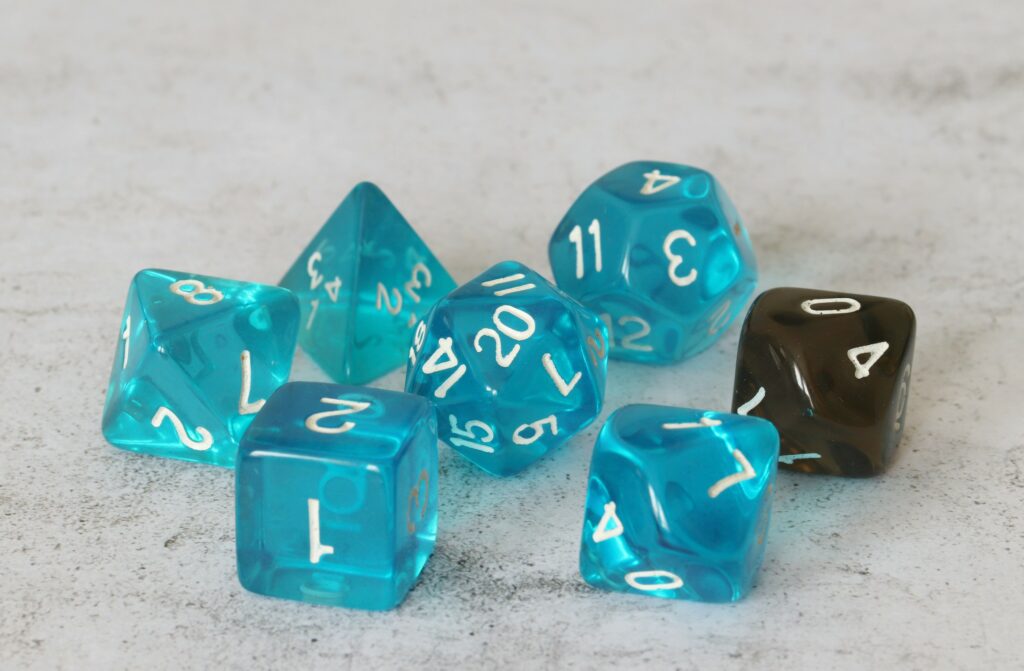
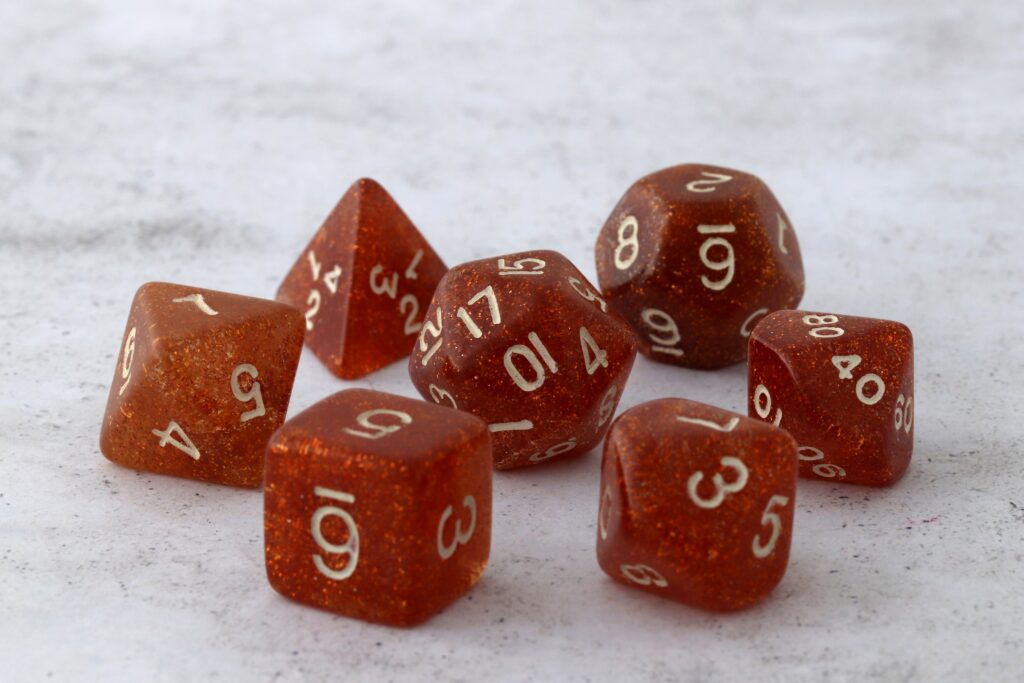
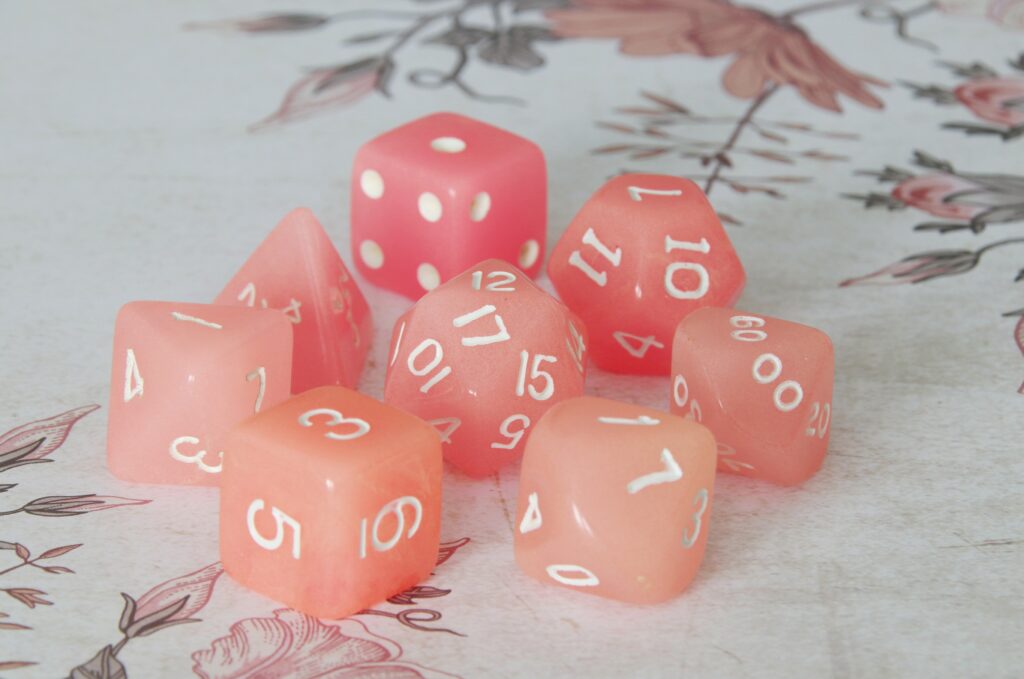
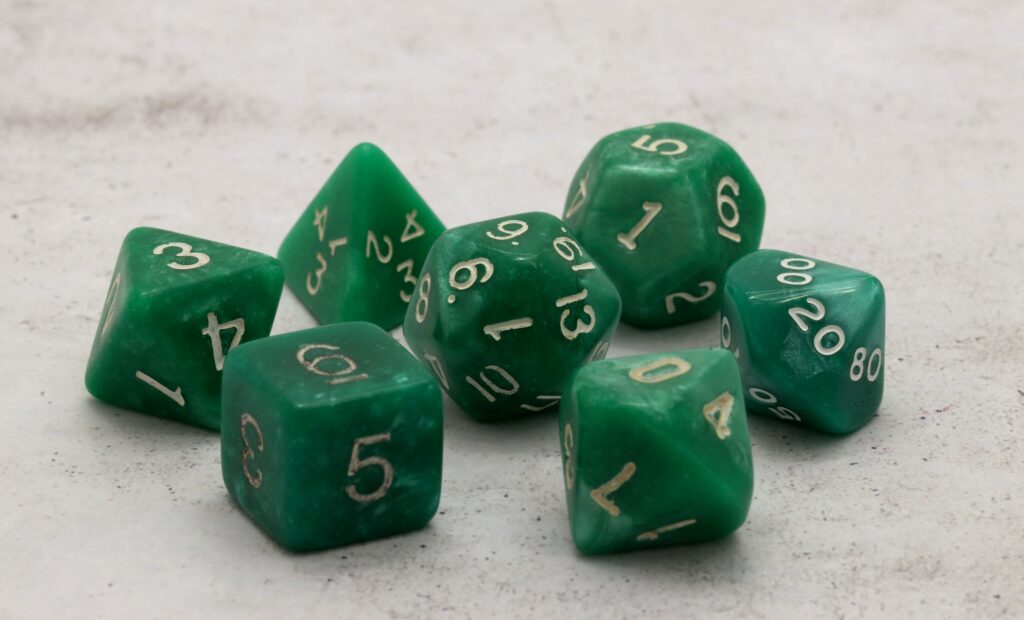
Gamescience
Gamescience is one of the manufacturers that produced sharp-edged, untumbled dice, which makes them quite unique and easy to identify. Gamescience dice are very pointy with crisp edges, are usually sold uninked, and have visible sprue marks.
There are several other vintage dice from the same era that look somewhat similar to Gamescience dice, e.g. the Mentzer sets, Holmes sets, various TSR dice, etc. I am not very familiar with dice from that era and cannot say much about how you can tell them apart.
Other people have written about this subject. A good place to start if you’re more interested in vintage dice is Jon Peterson’s blog post and Daniel L.’s Licensed D&D Dice Guide.
HengDa (HD) and other Chinese brands
HD dice are manufactured in China, and it’s unknown whether they use several factories or just one. The moulds for the HD dice are perhaps the closest to the new Chessex mould, but there are a few subtle differences.
While the 6 and 9 are usually also underlined, they are more rounded. The 1 has an upstroke, which is more pronounced than with the Chessex mould. The 7 is not hooked but has a curved vertical line, and the 0s are also more rounded. The percentile die has the numbers aligned perpendicular to the die equator. The numbers on the d4 are always top-read, the d20 has an 8 below the 20. The d6 is somewhat bigger than the Chessex d6.
HD and other Chinese brands tend to sell both acrylic and resin dice, and the fonts are very similar for both. Below is an example of the HD resin mould:

The Chinese generic acrylic mould can sometimes be told by the d4, which often tends to be a little smaller in size than the resin sets and has somewhat less elongated numbers (see middle die below).
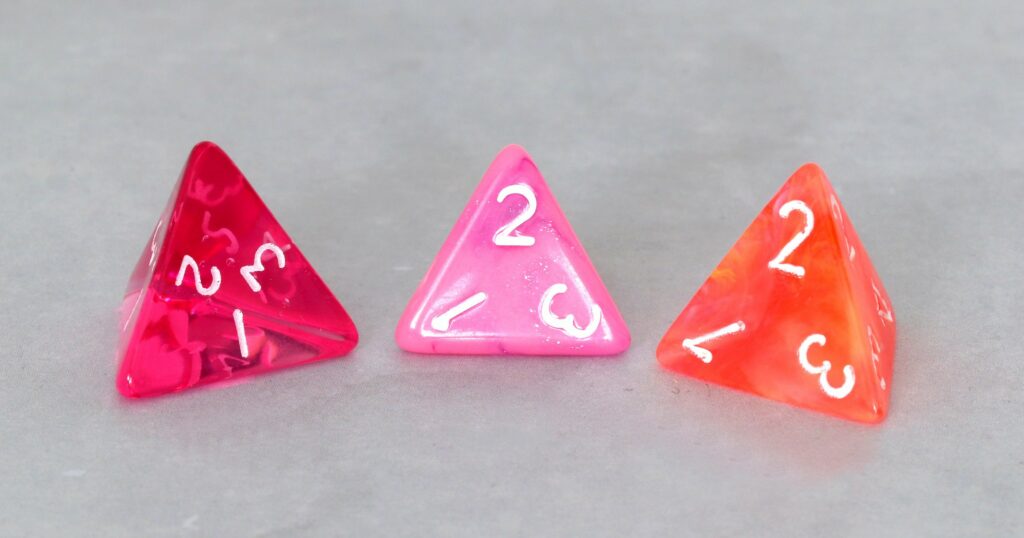
left: D&G, middle: Chinese acrylic, right: Chessex
Koplow
It’s harder to pin down an exact Koplow mould, since they seem to have been using different factories or moulds over time. They also sold the same dice Chessex does or did under the Koplow brand name (e.g. Chessex Sparkle and Koplow Glitter, Chessex and Koplow Speckled). There are a few lines that have very distinctive moulds that seem to be specific to Koplow, and that can you tell relatively easily by the way the font on the d12 or d20 looks.
The 1 has an upstroke and a horizontal line at the bottom. The 3 has a triangular top half, the 6 and 9 have a dot behind the number, the 7 has no hook and a curved vertical line, and the numbers themselves look rather wide. The d4 is usually bottom-read, and in some Koplow lines, the dot behind the 6 and 9 is quite large. Other Koplow moulds also have a dot behind the 16 and 19. For some moulds, the d20 has a 7 below the 20 (same as the Chessex Marbleized mould), for others a 17 below the 20.
Example of one of the Koplow moulds:

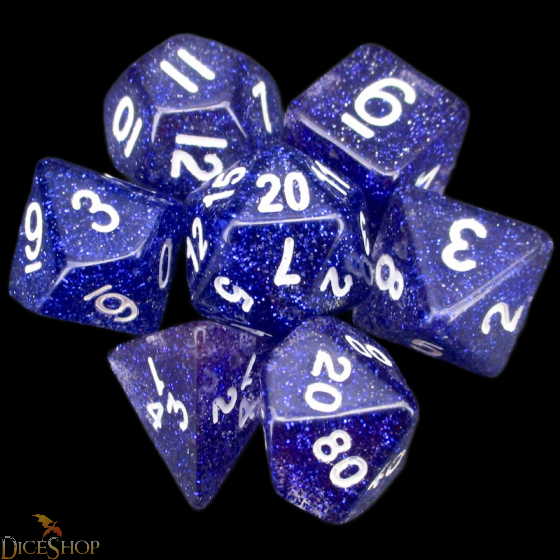
Koplow also has more modern moulds that use a different font altogether. They are using this mould on their most recent iteration of their Glitter dice.
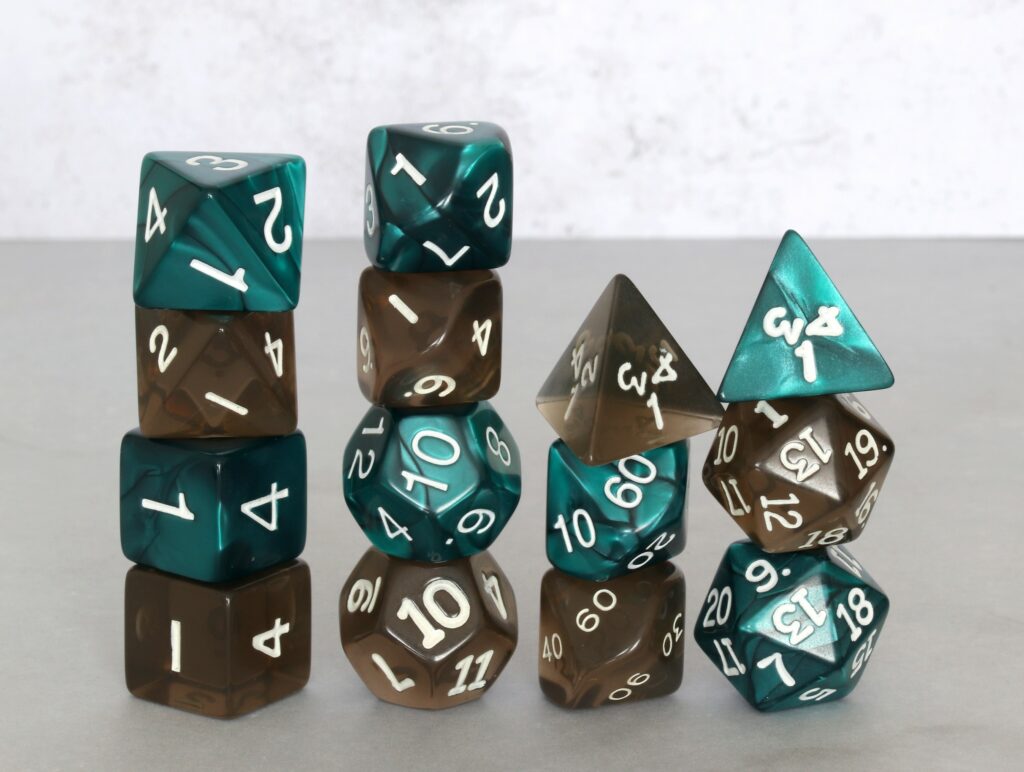
King Cards
King Cards is an older German company that no longer exists, who sold a number of different dice, some of which were the same or similar to existing dice. King Cards source their dice from different factories, among them D&G as outlined by the King Cards Pearl Lavender dice below.

Other dice sold by King Cards were made by the German acrylic factory and used the older German acrylic mould, although they also sold urea dice from the Danish factory in the mould that is also used for Chessex dice and that were the same as the dice that Chessex sold at the time.
Kraken
Kraken Dice has a number of signature lines exclusive to Kraken. They have different moulds for these, one of which has d20s and d2s with a stylized logo of a kraken as the 20 and the 2, respectively. While this mould is similar to other Chinese factory moulds, their font is somewhat leaner, and the top-read d4 sometimes has the numbers aligned close to the tips of the die. Another more distinctive feature of this Kraken signature mould is that the diagonal line of the 4 is slightly convex (i.e. bends outward).
Kraken signature dice sets are usually sold as 12-piece sets (regular 7-piece set plus a d2, one extra d20 and three extra d6s) or 14-piece sets (regular 7-piece set plus d2, three extra d6s and three extra d20s in different sizes).
In recent years, Kraken has changed their moulds and fonts and added new ones, for instance a d4 mould with truncated tips where the number is also visible in bird’s eye view. Please consult their website for how their different lines look these days.
Q-Workshop
The Polish manufacturer Q-Workshop makes dice with very distinctive designs, which are often inspired by certain themes such as runic, steampunk, Cthulhu, etc. Q-Workshop dice can usually be identified by the intricate patterns on their die faces that surround the numbers, or by the way the numbers themselves are depicted. There are many different designs in different colours available, and moulds and patterns are too diverse to cover the full range in this blog entry. Please note that most of the Q-Workshop dice are engraved and the numbers not classically moulded like in most of the acrylic and resin dice.
Wiz Dice
Wiz Dice are not always easily identifiable by mould, since they changed their moulds over time, and sometimes within the same line as well. The Wiz Dice moulds share certain characteristics with the more generic Chinese acrylic moulds.
Characteristics can vary within sets, e.g. some dice having underlined 6s and 9s, some dice having dots behind the 6 and 9. There are Wiz Dice lines with top-read d4s, and those with bottom-read d4s. Some Wiz Dice lines have larger d6s and tiny d4s, some lines have percentile dice that look the same as the HD mould (perpendicular to the die equator), while others have moulds with the number alignment parallel with the die equator and quite a large font. Some lines have very small d12s. The d20 has an 8 below the 20
Wiz Dice sets are not easy to identify by the mould alone, it is often the overall combination of mould, material, colour, design and finish that will tell you whether a die is by Wiz Dice or not. Below are two Wiz Dice sets that use completely different moulds.


Other Manufacturers
The list of manufacturers above is not exhaustive, and there are several brands not featured, such as Udixi, Yusun, HS Dice or T&G. The dice landscape has become rather complex over the past year or two, and it’s become more difficult to track and pin down brands and manufacturers.
Adding to that, not all dice lines will be attributable to one specific manufacturer or maker. It has become easier for small businesses or even private persons to have access to Chinese factories and get dice designed and manufactured. We see some of these in Kickstarters, but we also often see retailers or online stores selling dice where we don’t know the exact source. Small dice designers start cropping up here and there with exclusive lines, sometimes with exclusive moulds, like Bryce’s Dice, Beholder’s Gaze, Lindorm Dice, Libris Arcana or Fennek & Finch. Some factories sell their dice directly from China via brokers or Wish, Aliexpress, Temu or even via dropshippers on Etsy.
While the combined knowledge of the dice community will most likely be able to attribute Kickstarter lines made exclusively for one person or business, you may just end up with a die that you’ll have to ultimately catalogue as “unknown Chinese manufacturer”. Kickstarter or signature lines sometimes use d20 moulds that have a logo or symbol instead of the number 20, e.g. Critit ‘Spirit of’ dice, MDG’s Unicorn line, etc.
Lastly, there are also specialty dice, such as life counter spindowns or Amonkhet dice for Magic the Gathering, or level counter dice for games like Munchkin. These are usually quite specific and use very different moulds than the regular polyhedrals or pipped dice for the more classic RPGs.
Helpful Resources
- Michael Schäffer’s Dice DB (incl. dice moulds information)
- Kevin Cook’s Dice Collection website
- Jon Peterson’s ‘Identifying 1970’s Dice’ YouTube video and blog post
- Daniel L.’s Licensed D&D Dice Guide
- HD website #1, HD website #2
- Mel Shaw’s HD Dice Comparison Spreadsheet
- Bescon website
- Chessex website
- Crystal Caste website
- Dice & Games website
- GameScience website
- Koplow website
- Kraken website
- Q-Workshop website
- T&G website
- Wiz Dice website
- Chessex Borealis Glitter Identification Guide
- Crystal Caste Silk vs. D&G Marble Identification Guide
- Kevin Cook’s dice mould identification guide
- Michael Schäffer’s Dice DB page on dice moulds
- Orientation guide for pipped d6 by Lord of the Dice
Pages:
- 1
- 2

